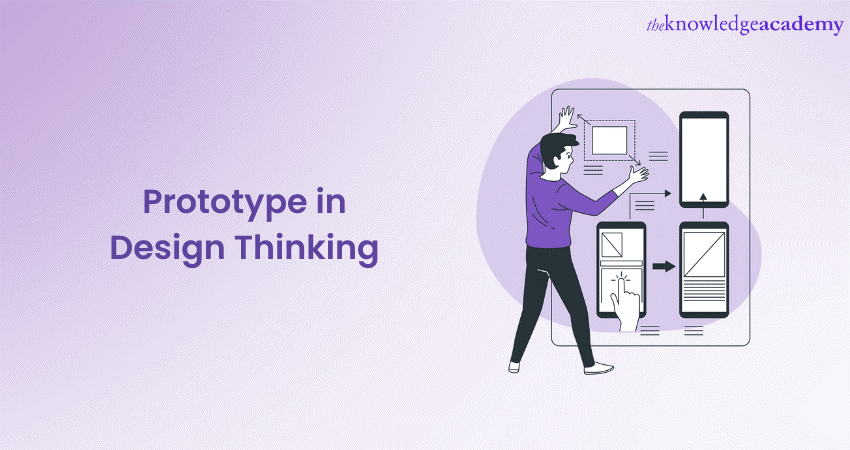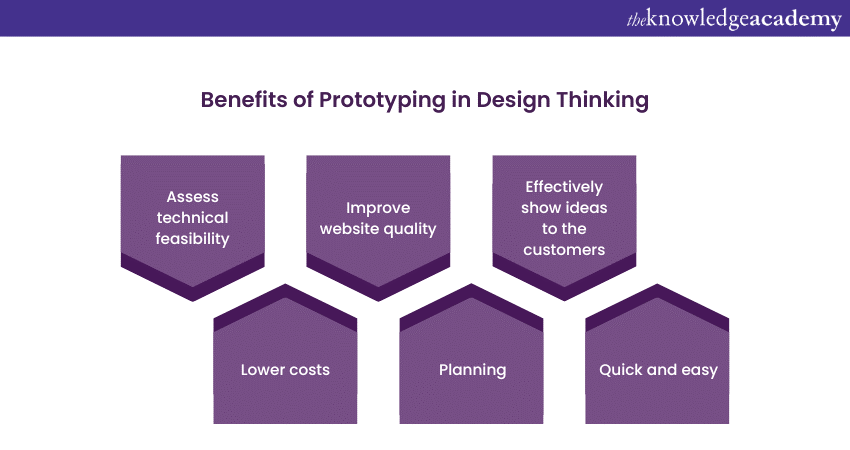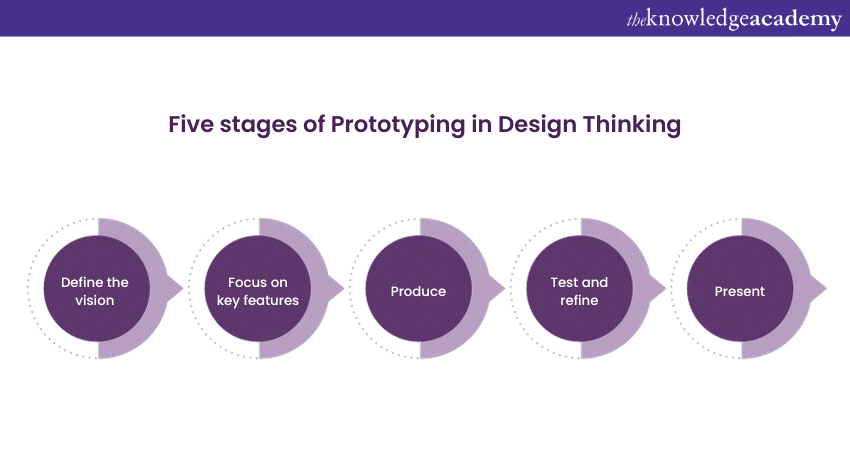We may not have the course you’re looking for. If you enquire or give us a call on 01344203999 and speak to our training experts, we may still be able to help with your training requirements.
Training Outcomes Within Your Budget!
We ensure quality, budget-alignment, and timely delivery by our expert instructors.

If you want to become a Product Designer, then one of the most important skills you can acquire is Design Thinking. As, Design Thinking is a human-centric methodology that places the needs of the users at the forefront of the design process.
A Prototype in Design Thinking includes everything from creating simple wireframes to testing complete functional copies of the product. Thus, it is a key step in the Design Thinking process. Explore our blog on Prototypes in Design Thinking to gain insights into its types, benefits, and how Prototype models function within an organisation.
Table of Contents
1) What is a Prototype?
2) Understanding Prototypes in Design Thinking
3) Types of Prototypes
4) How Prototyping works?
5) Benefits of Prototyping in Design Thinking
6) Five stages of Prototyping in Design Thinking
7) Conclusion
What is a Prototype?
A Prototype is a basic, experimental model of a proposed solution that is used to quickly and cost-effectively test or validate ideas, design assumptions and other aspects of its conceptualisation. This allows the designers involved to make appropriate refinements or changes in direction if necessary.
Prototypes can take many forms and the only commonality among them is that they are tangible representations of your ideas. They don't necessarily have to be basic versions of a final product, but can take various forms. For instance, simple sketches or storyboards can be used to demonstrate an experiential solution, rough paper Prototypes of digital interfaces can be created, and even role-playing can be utilised to act out a service offering an idea. It's important to note that Prototypes don't need to be full products but can be used to test specific parts of a solution, such as a proposed grip handle of a wheelchair.
Understanding Prototype in Design Thinking
Now, what is a Prototype in Design Thinking? It is a product’s early sample, release or model created to test the concept or the process. Usually, System Analysts and users operate on Prototypes to improve the accuracy of a new design.
The process of Prototyping is a very important phase in the Design Thinking procedure and is frequently used in the final testing step. Each product has its own target audience and is created to resolve its problem in every way. To check whether the product actually fixes the user's problem, Designers create an exemplary model or copy of the product, which is called a Prototype and test it according to the stakeholder's and users' perspectives.
Hence, this Prototype enables Designers to test the workability of the current product design and potentially look into the perspective of trail users regarding the current product. It allows testing to be done properly, exploring concepts of the design.
The aim of a Prototype in the Design Thinking procedure is to test or assess the product or product ideas before it is launched. Prototypes are copies or samples of final products used as testing tools. It is planned to test products and product ideas before infusing much time and resources into building a marketable product.
Developing Prototypes lets the Designers create simple, minor Prototypes of the products and utilise them to monitor, record, and evaluate user performance levels or their general behaviour and responses to the current design. Designers can then make suitable improvements or possible modifications with the right approach.
There are many forms of Prototypes, from simple sketches to rough paper Prototypes, that ratify service offerings. To create Prototypes, Designers do not need the complete product. In fact, they can take part of the product and create a Prototype to test only that particular part of the product.
Get yourself registered in our Design Thinking Training and get familiar with the Design Thinking process!
Types of Prototypes
The following are some common types of Prototypes:
1) Sketches and diagrams: Sketches and diagrams are the most basic type of Prototypes. It requires very little effort, and Designers do not need to have artistic drawing skills to serve the purpose. Designers can use sketches to start the process of analysing and creating a new product and also share the concept with their colleagues to have more ideas and discussions.
2) Paper interface: Digital products such as mobile apps, websites, web services, and more need a variety of Prototyping methods for the end design and development. The paper interface is a proven, easy and early-stage Prototype for digital products. Designers can sketch paper interfaces or sketch and cut out the useful parts of User Interfaces (UI), like a text field or drop-down menu.
3) Storyboards: Storyboarding is an incredible method of telling stories and directing targeted customers via a User Experience (UX). Storyboards let the Designers visualise how users would experience an issue or product and present it in a sequence of sketches or images. Stories help collect information about users, assignments, and objectives while simultaneously stimulating new ideas via collaboration with other designers.
4) Role-playing: Role-playing Prototype allows Designers to examine situations within the system they are targeting physically. Role-playing can capture and enact the user's experience (UX) with the help of a product or service. Consider imitating their expertise to achieve an empathic understanding of users. Designers can create props using objects and audio replications to emulate the user environment.
5) Physical models: A physical model conveys an intangible idea in a physical, three-dimensional form. This allows much better user testing and can stimulate discussions on the form factor of the suggested product.
6) User-driven Prototypes: In these types of Prototypes, Designers don't test User Experience(UX); instead, they let the user create some designs to understand more about their thinking process. This user-driven Prototype adds value to the advantages of Design Thinking. Its main motive is not to utilise the user-generated ideas but to utilise their designs to match the final product with the user’s ideas.
How Prototyping works?
Starting a project with a prototype can be beneficial in terms of setting your overall objectives and, more critically, identifying what is not functioning properly upfront. The following are three stages of the prototype in Design Thinking that illustrate how the prototype operates.
1) Action-oriented bias: In order to truly test your assumptions, it is important to put them into practice rather than just thinking about them conceptually. An analytical study alone will not suffice. By conducting controlled tests in the actual environment, you can either validate or reject your assumptions, which can help you further develop your idea or even discard it altogether. It is in this way that you can gain a deeper understanding of the viability of your concept.
2) Finding out through doing: Design Thinking places significant importance on discovering new insights and exploring uncharted possibilities. As a result, the discipline focuses on education and team-building exercises that enhance learning potential. This enables your team to iterate quickly, refine test models and ultimately bring you closer to achieving your desired outcome.
3) Ingenious serendipity: It is often assumed that cultivating a success mindset is as easy as flipping a switch. This belief is encouraged by the promotion of ground-breaking technologies, start-ups, and new ideas, all of which are designed to inspire and encourage creativity. Prototyping is a valuable tool that enables you and your team to observe and discuss the advantages and disadvantages of your ideas, learn from customer feedback, and identify small opportunities for creative exploration.
Benefits of Prototyping in Design Thinking

It's time to understand how you can enjoy the various benefits of Prototyping in Design Thinking. Here are some of the key benefits:
1) Assess technical feasibility: When you create a Prototype, it makes the idea of the concretisation process possible and smooth. Additionally, it also evaluates which feature is leading to difficulty in implementation. Hence, Prototyping in Design Thinking can assist in identifying unpredictable technical, physical, and financial restrictions.
2) Improve website quality: A Prototype allows to improve the website quality. A well-designed and well-thought-out website assists in conducting the Design Thinking Process. It means Designers can conduct testing for site usability, inspect site navigation, determine correct placement and access information on the site.
3) Effectively show ideas to the customers: Efficiently thinking about the design of the Prototype makes it feasible to show your future product or product idea to potential consumers before its actual launch in the market. It also enables you to come up with better marketing strategies and begin the pre-sales.
4) Lower costs: A great idea can create various Prototypes before the launch of the actual product, and it can ultimately lead to cutting down the additional costs of unsold products.
5) Planning: Through Prototyping, the design team gets important information that helps them plan the undertaking. A Prototype assists in building user stories and emphasising user needs. This fetches significant benefits to the scrum teams.
6) Quick and easy: Prototyping is a very quick and smooth procedure. A Designer can design a ready-to-use Prototype in no time ever with the help of simple ideas on paper if they understand the functionality and logic of the product.
Five stages of Prototyping in Design Thinking

Prototyping refers to the process of developing a Prototype. The following are the five stages of Prototyping utilised in the Design Thinking process. Let’s understand each stage:
Define the vision
In this stage of Prototyping, the Designer is required to put forward an extensive vision for the product. This stage involves asking a few key questions that must be answered, such as what the target market is, how many other options are available, what problem it resolves, and how much labour and material is required. Answering these key questions gives the Designer clarification on whether the Prototypes are even needed.
Focus on key features
One of the most common mistakes Designers make is that they try to create a Prototype similar to the end product. Designers can use this idea when illustrating its value to the investors, but it is necessary in other requirements. The Designer should pick out one or two key product features to concentrate on in their Prototype.
Produce
The actual creation of the Prototype is the lengthiest part, as the creator has to assess all the options involved. Some standard Prototyping methods to consider include the following:
1) 3D printing: This is a wonderful option when the Designer has a clear vision and wants to quickly test its effectiveness and operation.
2) Computer Numerical Control (CNC) machining: It’s a procedure that eradicates potential human mistakes. The product is automated and machine-controlled.
3) Powder bed fusions: This is a method particularly created for aluminium or metal materials with high melting points.
4) Mould making and casting: This process enhances flexibility and is suitable for creating custom designs and parts without the requirement for computer input.
Test and refine
After creating the initial Prototype, the Designer now has to evaluate it, consider new options, and look for methods to improve the complete procedure. This procedure may include throwing out the initial design and restarting from step one. At any point, testing and refining should arise numerous times to make sure the Prototype is ready to be revealed to stakeholders.
Present
This is called the presentation stage, and it varies according to the objective of the Prototype. It may involve designing various models for testing among consumers, shipping the design in for patenting, or showing it to investors.
Register for our Design Thinking For R&D Engineers Training and learn how Design Thinking used as a management tool for R&D projects.
Conclusion
We hope that you found this blog insightful. In this blog, we have guided you through the whole concept of Prototyping, such as What is a Prototype in Design Thinking, the benefits of Prototyping and much more. The utilisation of Prototypes is paramount for Product Designers and design teams.
Check out our Creative And Analytical Thinking Training now and gain an in-depth understanding of Analytical thinking in the Design Thinking process!
Frequently Asked Questions
Upcoming Business Skills Resources Batches & Dates
Date
 Successful People Management and Team Leadership
Successful People Management and Team Leadership
Fri 7th Jun 2024
Fri 2nd Aug 2024
Fri 4th Oct 2024
Fri 6th Dec 2024







 Top Rated Course
Top Rated Course




 If you wish to make any changes to your course, please
If you wish to make any changes to your course, please


